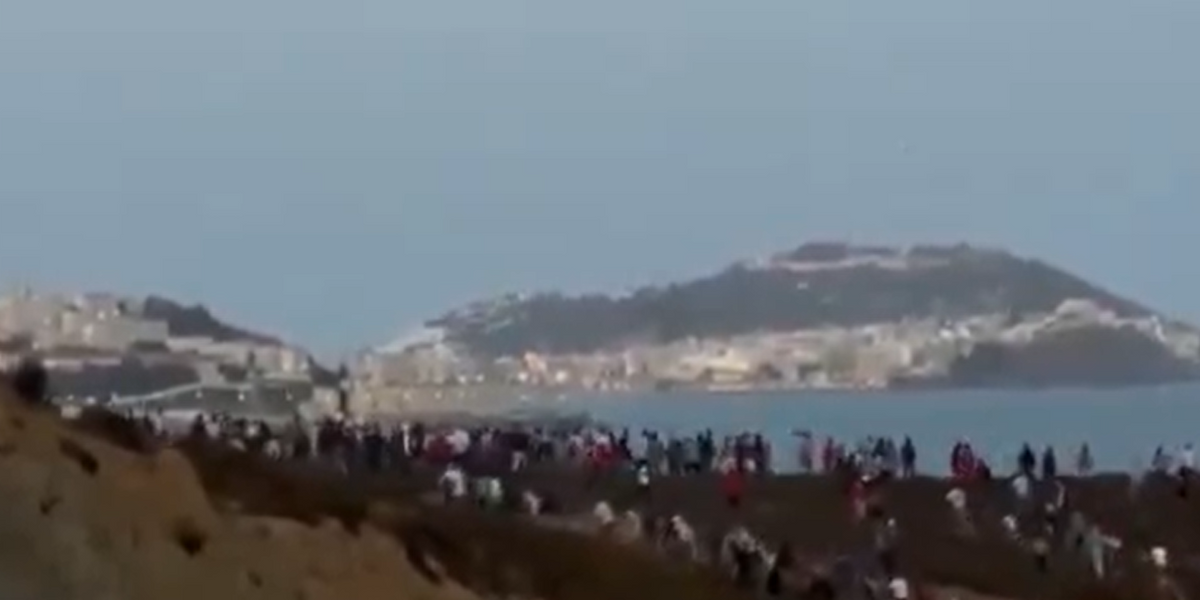Title: Chaos at the Ceuta Border: A Surge of Migrants Attempting to Enter the EU
In a dramatic and alarming scene, hundreds of African migrants were filmed attempting to storm the Spanish border in a coordinated effort to enter the European Union. This chaotic event unfolded on Sunday at the border separating Morocco and the Spanish enclave of Ceuta, highlighting the ongoing challenges of migration in the region.
The Scene of the Attempted Crossing
The situation escalated in the border town of Fnideq, where migrants were seen rushing across a hilltop towards the border. As the crowd surged, Moroccan security forces were compelled to form a human barrier to prevent the migrants from breaching the barbed wire fence that marks the boundary into Spain. The urgency of the situation was underscored by the officers firing warning shots into the air in an attempt to disperse the throng of hopeful migrants.
In addition to the tumultuous land crossings, groups of migrants were also spotted attempting to swim across the beaches of Castillejos and Beliones, further illustrating the lengths to which individuals are willing to go in search of a better life in Europe. Tragically, the body of a migrant was discovered following the attempted breach, a stark reminder of the dangers associated with such perilous journeys.
A Pattern of Migration at Ceuta and Melilla
Ceuta and Melilla, Spain’s two enclaves bordering Morocco, have long been focal points for irregular migration attempts. These territories serve as gateways to the European Union, attracting migrants from various African nations seeking refuge or better economic opportunities. The recent surge in crossings is not an isolated incident; rather, it reflects a broader trend of increasing migration pressures in the region.
Authorities reported that at least 60 individuals were arrested in the days leading up to the mass crossing attempt. This uptick in migration activity comes on the heels of Spanish Prime Minister Pedro Sanchez’s visit to three African countries earlier this year, during which he pledged to enhance cooperation to manage the rising number of crossings.
Rising Numbers and EU Response
The situation at Ceuta is part of a larger narrative concerning migration into Europe. Recent statistics reveal a staggering 160% increase in the number of migrants arriving in the Canary Islands between January and mid-July compared to the previous year, totaling nearly 20,000 individuals. This surge is indicative of the desperation many face in their home countries, prompting them to undertake dangerous journeys in search of safety and stability.
As the European Union braces for a potential influx of asylum applications, projections suggest that the EU could receive approximately one million applications in 2024. In the first half of this year alone, 513,000 applications were logged, slightly fewer than during the same period in 2023. The European Union Agency for Asylum (EUAA) anticipates that EU+ countries, which include the 27 EU member states along with Norway and Switzerland, may see around one million applications by the end of the year. This would mark the second consecutive year of such high numbers, reminiscent of the migration crisis experienced in 2016.
Conclusion: A Complex Challenge Ahead
The recent events at the Ceuta border underscore the complexities and challenges surrounding migration in Europe. As individuals continue to seek refuge and better opportunities, the response from both European and African nations will be critical in addressing the root causes of migration and ensuring the safety and dignity of those involved. The situation remains fluid, and as authorities grapple with the immediate challenges, the need for comprehensive and humane migration policies has never been more pressing.
